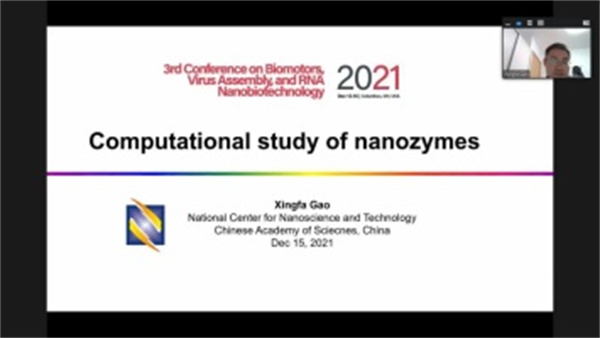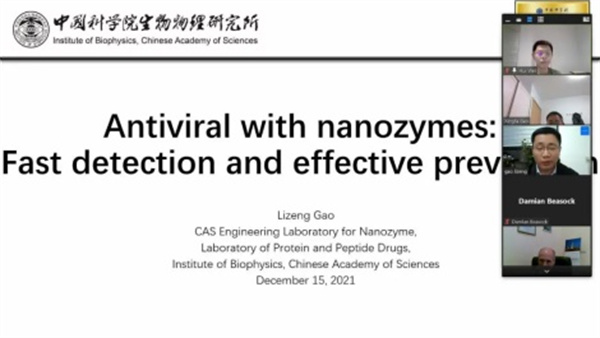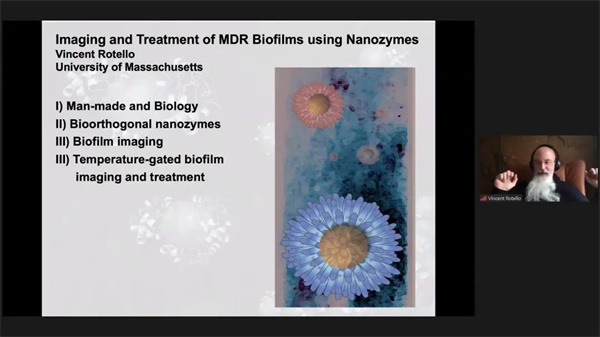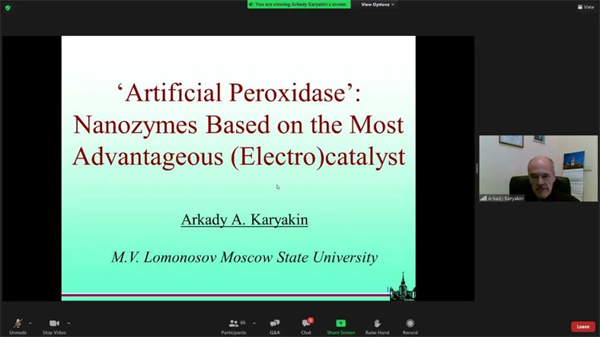Home> News
Nanozyme branch of BSC hosts special forum at key conference on biomotors, virus assembly and RNA nanobiotechnology
Updated: 2021-12-21
The Third Conference on Biomotors, Virus Assembly, and RNA Nanobiotechnology hosted by Ohio State University in Columbus, Ohio, the United States was held online from Dec 13 to 16.
With the theme “motile nanobeing: the world at nanoscale”, the conference had Guo Peixuan, a professor from Ohio State University, as its chair and invited leading scientists and engineers in the fields of chemistry, biochemistry, biophysics, structural biology, microbiology, cell biology, materials and nanotechnology, aiming to foster exchanges.
As part of the conference, a special forum on nanozymes: the next generation of artificial enzymes organized by the Nanozyme Academic Subgroup of the Biophysical Society of China (BSC) was held on Dec 15.
The forum was presided over by Wei Hui, a professor from Nanjing University. Experts from renowned universities and institutions from China and abroad participated in the forum and delivered reports.

Gao Xingfa, a research fellow from the National Center for Nanoscience and Technology, delivers a report on the computational study of nanozymes at the special forum on Dec 15. [Photo provided to bsc.org.cn]
Gao Xingfa, a research fellow from the National Center for Nanoscience and Technology, delivered a report on the computational study of nanozymes, in which he explained basic issues in the de novo design of nanozymes, micro-mechanism and kinetics of nanozymes, and research findings related to nanozymes’ activity descriptors and prediction models.

Gao Lizeng, a researcher from the Institute of Biophysics at the CAS, gives a speech at the special forum on Dec 15. [Photo provided to bsc.org.cn]
Gao Lizeng, a researcher from the Institute of Biophysics at the Chinese Academy of Sciences (CAS), gave a speech titled “antiviral with nanozymes: fast detection and effective prevention”. Gao talked about the application of nanozymes in virus detection, colorimetric methods and chemiluminescence signals, as well as antibacterial activities and catalytic immune adjuvants.

Vincent Rotello, a professor from the University of Massachusetts, shares his studies on nanozymes on Dec 15. [Photo provided to bsc.org.cn]
Vincent Rotello, a professor from the University of Massachusetts, gave a report titled “nanoparticle-and polymer-based nanozymes: harnessing the power of transition metal catalysis for bioorthogonal chemistry”. Rotello shared his studies on bioorthogonal chemistry and explained the potential of biorthogonal nanozymes inorganometallic chemistry, imaging agent regulation, drug localization, biofilm imaging and temperature-gated biofilm imaging and treatment.

Arkady Karyakin, a professor from M.V. Lomonosov Moscow State University, gives a speech titled “artificial peroxidase: nanozymes based on the most advantageous (electro) catalyst” on Dec 15. [Photo provided to bsc.org.cn]
Arkady Karyakin, a professor from M.V. Lomonosov Moscow State University, gave a report on artificial peroxidase: nanozymes based on the most advantageous (electro) catalyst. He expounded on the catalytic mechanism and kinetic data of the peroxidase mimicking activity of nanozymes and made comparisons with the performance of enzymes.
Following the speeches, experts and scholars exchanged views on major issues in the field.
